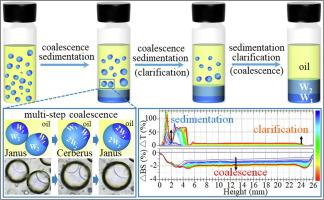Journal of Colloid and Interface Science ( IF 9.4 ) Pub Date : 2020-11-20 , DOI: 10.1016/j.jcis.2020.11.062 Haimei Jin , Lingling Ge , Xia Li , Rong Guo

|
Hypothesis
Reverse Janus emulsion, with droplets composed by “two rooms” of water phases, is a novel multiple emulsion attributed to excellent integration capability and biocompatibility. However, significant instability compared with normal Janus emulsions renders the stability issue of great importance. Moreover, the ultra-low aqueous-aqueous inner interfacial tension, the anisotropic nature of the droplets with distinct lobe composition, and the random orientation in the continuous phase endow the complicated and various demulsification mechanisms.
Experiments
Reverse Janus emulsion of (W1+W2)/O, employing typical salt-alcohol aqueous two-phase system (ATPS) as inner phases, is prepared in batch scale by conventional one-step vortex mixing. The demulsification process is detected by multiple light scattering technique, which provides real-time, in-situ, and quantitative information of emulsion evolution. Moreover, the fusion pattern of the anisotropic droplets is illustrated by the combination with light microscopy and size distribution measurement.
Findings
Coalescence and sedimentation are found to be two main demulsification processes. Two salt “body” lobes of the “snowman” shaped Janus droplets combine first resulting in an intermediate Cerberus topology with two alcohol “heads” on one salt “body”. Subsequently, two “head” lobes coalesce resulting in a larger Janus droplet. Ultimately, the Gibbs free energy leads to a final state with three separated liquids. In addition, the variation in lobe viscosity, density, and properties of interfacial film greatly affect the demulsification rate and fusion pattern. A critical alcohol/surfactant mass ratio of 2 is found, beyond which a completely different fusion pattern occurs. Two alcohol “body” lobes combine first resulting in an intermediate Cerberus topology with two salt “heads” on one alcohol “body”. Subsequently, two “head” lobes coalesce resulting in a larger Janus droplet. The findings are instructive in the stability of aqueous based multiple emulsions with advanced morphologies and meanwhile, promote the future application of this novel emulsion in food science, pharmacy, and biomimetic compartmentalization.
中文翻译:

(W 1 + W 2)/ O反向Janus乳液的失稳机理
假设
反向Janus乳液具有由“两室”水相组成的液滴,是一种新型的多重乳液,归因于出色的整合能力和生物相容性。但是,与普通的Janus乳液相比,明显的不稳定性使稳定性问题变得非常重要。此外,超低的水-水内部界面张力,具有不同叶组成的液滴的各向异性和连续相中的无规取向赋予了复杂而多样的破乳机理。
实验
(W 1 + W 2)/ O的反向Janus乳液,采用典型的盐-醇水相两相体系(ATPS)作为内相,通过常规的一步涡旋混合分批制备。破乳过程通过多重光散射技术进行检测,该技术可提供乳剂演变的实时,原位和定量信息。此外,通过与光学显微镜和尺寸分布测量相结合来说明各向异性液滴的融合图案。
发现
发现聚结和沉降是两个主要的破乳过程。“雪人”形状的Janus液滴的两个盐“体”瓣首先结合在一起,形成中间的Cerberus拓扑结构,其中一个盐“体”上有两个酒精“头”。随后,两个“头”瓣合并,导致更大的Janus液滴。最终,吉布斯自由能导致三种分离液体的最终状态。另外,波瓣粘度,密度和界面膜性能的变化极大地影响了破乳速率和熔融方式。发现临界的醇/表面活性剂质量比为2,超过此比率,将出现完全不同的熔融模式。两个酒精“体”瓣首先结合在一起,形成一个中间的Cerberus拓扑结构,一个酒精“体”上有两个盐“头”。后来,两个“头”裂片合并,形成较大的Janus液滴。这些发现对具有先进形态的水基多重乳液的稳定性具有指导意义,同时,促进了这种新型乳液在食品科学,药学和仿生分隔中的未来应用。











































 京公网安备 11010802027423号
京公网安备 11010802027423号